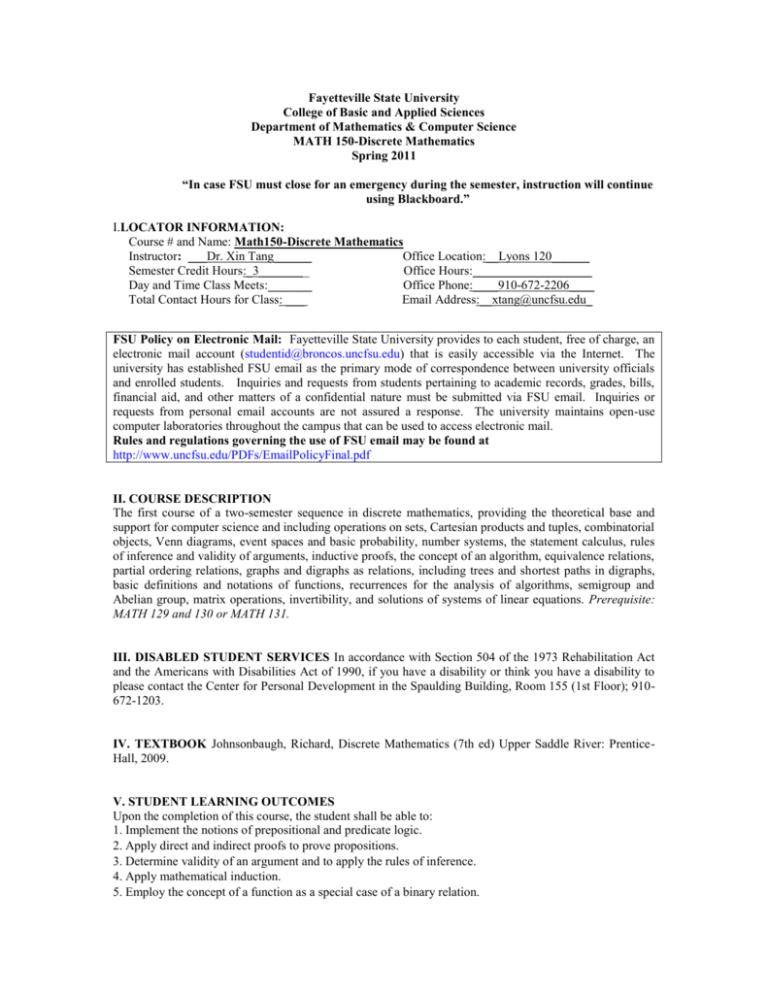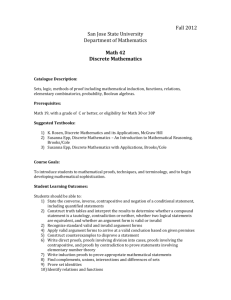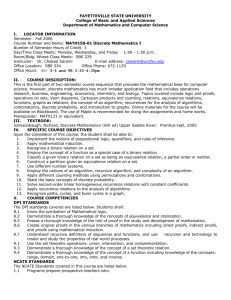Course Syllabus - Fayetteville State University
advertisement

Fayetteville State University College of Basic and Applied Sciences Department of Mathematics & Computer Science MATH 150-Discrete Mathematics Spring 2011 “In case FSU must close for an emergency during the semester, instruction will continue using Blackboard.” I.LOCATOR INFORMATION: Course # and Name: Math150-Discrete Mathematics Instructor: ___Dr. Xin Tang______ Office Location:__Lyons 120______ Semester Credit Hours:_3________ Office Hours:___________________ Day and Time Class Meets:_______ Office Phone:____910-672-2206____ Total Contact Hours for Class: ___ Email Address:__xtang@uncfsu.edu_ FSU Policy on Electronic Mail: Fayetteville State University provides to each student, free of charge, an electronic mail account (studentid@broncos.uncfsu.edu) that is easily accessible via the Internet. The university has established FSU email as the primary mode of correspondence between university officials and enrolled students. Inquiries and requests from students pertaining to academic records, grades, bills, financial aid, and other matters of a confidential nature must be submitted via FSU email. Inquiries or requests from personal email accounts are not assured a response. The university maintains open-use computer laboratories throughout the campus that can be used to access electronic mail. Rules and regulations governing the use of FSU email may be found at http://www.uncfsu.edu/PDFs/EmailPolicyFinal.pdf II. COURSE DESCRIPTION The first course of a two-semester sequence in discrete mathematics, providing the theoretical base and support for computer science and including operations on sets, Cartesian products and tuples, combinatorial objects, Venn diagrams, event spaces and basic probability, number systems, the statement calculus, rules of inference and validity of arguments, inductive proofs, the concept of an algorithm, equivalence relations, partial ordering relations, graphs and digraphs as relations, including trees and shortest paths in digraphs, basic definitions and notations of functions, recurrences for the analysis of algorithms, semigroup and Abelian group, matrix operations, invertibility, and solutions of systems of linear equations. Prerequisite: MATH 129 and 130 or MATH 131. III. DISABLED STUDENT SERVICES In accordance with Section 504 of the 1973 Rehabilitation Act and the Americans with Disabilities Act of 1990, if you have a disability or think you have a disability to please contact the Center for Personal Development in the Spaulding Building, Room 155 (1st Floor); 910672-1203. IV. TEXTBOOK Johnsonbaugh, Richard, Discrete Mathematics (7th ed) Upper Saddle River: PrenticeHall, 2009. V. STUDENT LEARNING OUTCOMES Upon the completion of this course, the student shall be able to: 1. Implement the notions of prepositional and predicate logic. 2. Apply direct and indirect proofs to prove propositions. 3. Determine validity of an argument and to apply the rules of inference. 4. Apply mathematical induction. 5. Employ the concept of a function as a special case of a binary relation. 6. Classify a given binary relation on a set as being an equivalence relation, a partial order or neither. 7. Construct a partition given an equivalence relation on a set. 8. Use different number systems. 9. Employ the notions of an algorithm, recursive algorithm, and complexity of an algorithm. 10. Apply different counting methods using permutations and combinations. 11. State the basic concepts of discrete probability. 12. Solve second-order linear homogeneous recurrence relations with constant coefficients. 13. Apply recurrence relations to the analysis of algorithms. 14. Recognize paths, cycles, and Euler cycles in a graph. Course Competencies: Dpi Standards The DPI standards covered are listed below. Students shall: 8.1 Know the symbolism of Mathematical logic. 8.2 Demonstrate a thorough knowledge of the concepts of equivalence and implication. 8.5 Posses a thorough knowledge of the role of proof in the study and development of mathematics. 8.6 Create original proofs in the various branches of mathematics including direct proofs, indirect proofs, and proofs using mathematical induction. 8.7 Understand recursive definition of sequences and functions, and use recursion and technology to model and study the properties of real world processes. 9.1 Use the set theoretic operations: union, intersection, and complementation. 9.3 Demonstrate a thorough knowledge of the concept of a set theoretic relation. 9.4 Demonstrate a thorough knowledge of the concept of a function including knowledge of the concepts: range, domain, one-to-one, into, onto, and inverse. Ncate Standards The NCATE Standards covered in this course are listed below. 1.1 Programs prepare prospective teachers who: 1.1.1 Use a problem-solving approach to investigate and understand mathematical content. 1.1.2 Formulate and solve problems from both mathematical and everyday situations. 1.2.1 Communicate mathematical ideas in writing, using everyday and mathematical language, including symbols. 1.2.2 Communicate mathematical ideas orally, using both everyday and mathematical language. 1.3 Programs prepare prospective teachers who can make and evaluate mathematical conjectures and arguments and validate their own mathematical thinking. 1.4 Programs prepare prospective teachers who: 1.4.1 Show an understanding of the interrelationship within mathematics. 1.4.2 Connection of mathematics to other disciplines and real-world situations. 1.5 Programs prepare prospective teachers who: 1.5.1 Understand and apply of concepts of number, number theory, and number systems. 1.6 Programs prepare prospective teachers who: 1.6.1 Use of calculators in computational and problem-solving situations. 1.6.2 Use computer software to explore and solve mathematical problems. VI. EVALUATION CRITERIA/GRADING SCALE Homework will be collected regularly. There will be four tests, and a comprehensive final exam. The lowest test score and the lowest homework score will be dropped. The weight given to various activities for evaluation is as follows: Homework-20%, Tests-45%, Final Exam-25%, Participation-10%. There will be some extra credit from popup quizzes. There will be a 10% penalty per day for a late homework assignment. Late homework will no longer be accepted after the corresponding graded assignments are returned to class. Grading Scale: A 90 - 100% B 80 - 89% C 70 - 79% D 60 - 69% F Below 60% VII. ACADEMIC SUPPORT RESOURCES-Additional course information will be announced through Blackboard. Students are encouraged to seek the instructor’s help during the office hours on topics they find difficult to understand. In addition tutoring is available in the University College Learning Center located in room 216-C of Helen T. Chick Building. VII. TENTATIVE COURSE OUTLINE Note: This schedule is subject to change for the optimum benefit of the class as a whole, and homework assignments will be announced in classes. 1.1. Sets 1.2. Propositions 1.3. Conditional Propositions and Logic Equivalence 1.4. Arguments and Rules of Inference 1.5. Quantifiers 1.6. Nested Quantifiers 2.1. Mathematical Systems, Direct Proofs, and Counterexamples 2.2. More Methods of Proof Test #1 2.3. Resolution Proofs 2.4. Mathematical Induction 3.1. Functions 3.2. Sequences and Strings 3.3. Relations 3.4. Equivalence Relations 3.5. Matrices of Relations Test #2 4.1. Introduction 4.2. Examples of Algorithms 4.3. Analysis of Algorithms 4.4. Recursive Algorithms 5.1. Divisors 5.2. Representations of Integers and Integer Algorithms 5.3. The Euclidean Algorithm Test #3 6.1. Basic Principles 6.2. Permutations and Combinations 6.3. Generalized Permutations 6.4. Algorithms for Generating Permutations and Combinations 6.5. Introduction to Discrete Probability 6.7. Binomial Coefficients and Combinatorial Identities 7.1. Introduction to Recurrence Relations Test #4 7.2. Solving Recurrence Relations 7.3. Applications to the Analysis of Algorithms Final Exam (comprehensive) VIII. COURSE REQUIREMENTS 1. Students are responsible for availing themselves of all class meetings. 2. Students are expected to enter the classroom on time and remain until the class ends so that distractions may be kept at a minimum. Please be considerate of your fellow students. 3. Students are encouraged to ask questions of the instructor in class and to respond to those posed by the instructor. They should not discourage others from asking or answering questions. Other students often have the same questions on their minds, but are hesitant to ask. 4. Students are expected to complete all class assignments and to spend adequate time at home on their class work to insure that the course outcomes are met. 5.Talking in class between students is strictly unacceptable. Discussions should be directed to the instructor. 6. Late homework will no longer be accepted after it has been graded and returned to class. 7. Questions on the grading of a test are allowed only during the class period when the test is returned. 8. If you miss a test you can have a make-up test only with a documented excuse. IX. TEACHING STRATEGIES The majority of the material of this course will be given in lecture format. There will be a short review before and after each lecture. Student discussions, cooperative learning groups will be strongly encouraged. X. REFERENCES Johnsonbaugh, Richard, Discrete Mathematics (6th ed) Upper Saddle River: Prentice-Hall, 2005. nd Goodaire, Edgar G., Parmenter, Michael M., Discrete Mathematics with Graph Theory, 2 ed. Upper Saddle River: Prentice-Hall, 2002. Gossett, Eric, Discrete Mathematics with Proofs, Upper Saddle River: Prentice-Hall, 2003. Ross, Kenneth A., Wright, Charles R.B., Discrete Mathematics. 5th ed. Upper Saddle River: Prentice-Hall, 2003






